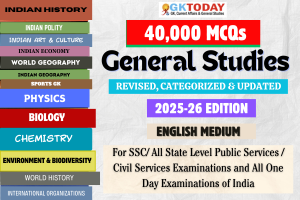Modern Indian History MCQs
Multiple choice questions on Modern Indian History & Freedom Struggle for General Studies and GK preparation of SSC, NDA, CDS, UPSC, UPPSC and State PSC Examinations.
41. Which of the following did not participated in the Second Round Table Conference?
[A] Mahadev Desai
[B] Pyarelal Nayyar
[C] Madan Mohan Malaviya
[D] Jawaharlal Nehru
Show Answer
Correct Answer: D [Jawaharlal Nehru]
Notes:
The Second Round Conference opened on September 7, 1931. Gandhi represented the Indian National Congress and Sarojini Naidu represented Indian women. Jawaharlal Nehru did not participate in the Second Round Table Conference.
42. In which year, Bangbhasha Prakasika Sabha was established?
[A] 1831
[B] 1836
[C] 1839
[D] 1841
Show Answer
Correct Answer: B [1836]
Notes:
Bangbhasha Prakasika Sabha was founded in 1836 by associates of Raja Ram Mohan Roy. It was the first organized political association of India and it worked for reform of administrative association of Indians with the British, spread of education, pushing forward Indian demands to the British parliament.
43. The British Indian Association of Calcutta was founded in which of the following year?
[A] 1836
[B] 1848
[C] 1851
[D] 1858
Show Answer
Correct Answer: C [1851]
Notes:
The British Indian Association of Calcutta was formed in 1851 by the merger of the Bengal British India Society and the Landholders’ Society. It was established to convey the grievances of Indians to the British Govt.
44. Who founded the ‘India House’ in London on 1 July 1905 ?
[A] Shyamji Krishna Varma
[B] Bhikaji Cama
[C] Dadabhai Naoroji
[D] SR Rana
Show Answer
Correct Answer: A [Shyamji Krishna Varma]
Notes:
Shyamji Krishna Varma founded the ‘India House’ in London on 1 July 1905 as a hostel for Indian students, since most faced racist discrimination when seeking accommodation. India House soon became a hub of Indian nationalists and revolutionaries, the notables being Madan Lal Dhingra, Madame Bhikaji Rustom Cama, Lala Har Dayal, Veer Savarkar and many others.
45. In which year, the Shimla conference took place to discuss provisions of the Wavell Plan?
[A] 1944
[B] 1945
[C] 1946
[D] 1947
Show Answer
Correct Answer: B [1945]
Notes:
To discuss the provisions of the Wavell Plan a conference of 21 Indian Political leaders was invited to the Summer Capital of British Government Shimla. The leaders included Maulana Abul Kalam Azad, who was the President of the Congress at that time. Mohammad Ali Jinnah also reached in the conference. Here, Jinnah said that no non-league Muslim should be represented to the Executive Council because only Muslim League has right to represent the Muslims of India. He also wanted that all Muslim representatives should be from Muslim League. So, it was said that Congress had no right to nominate any Muslim in the Executive council. This was the main reason of failure of the Wavell Plan.
46. Who among the following is best known for working with Khan Abdul Ghaffar Khan in N.W.F.P?
[A] Sucheta Kripalani
[B] Khurshedbehn Naoroji
[C] Sheorajvati Nehru
[D] Sarla Behn
Show Answer
Correct Answer: B [Khurshedbehn Naoroji]
Notes:
Khurshedbehn Naoroji was the grand·daughter of Dadabhai Naoroji. She is known to have participated in salt satyagraha of 1930. She is best known for working with Khan Abdul Ghaffar Khan in N.W.F.P.
47. The Azad Hind Radio was started in which year?
[A] 1939
[B] 1942
[C] 1944
[D] 1945
Show Answer
Correct Answer: B [1942]
Notes:
In the year 1942, The Azad Hind Radio service was started in Germany by the leadership of Netaji Subhas Chandra Bose. Its objective was to encourage Indian freedom fighters. The headquarters of Azad Hind Radio were shifted to Singapore and later to Rangoon.
48. Who among the following British persons admitted the Revolt of 1857 as a national revolt?
[A] Lord Dalhousie
[B] Lord Ellenborough
[C] Disraeli
[D] Lord Canning
Show Answer
Correct Answer: C [Disraeli]
Notes:
Benjamin Disraeli, the leader of the conservative party of England has called it a “National revolt.” “The motives of leadership of revolt, geographical extent of the sway of revolt, its loose organizational infrastructure and the fragile basis of national consciousness at that moment do not provide substance to the so-called characterization of sepoy mutiny as “National struggle.”
49. Who among the following participated in the Salt Satyagraha of Gandhiji?
[A] Kamladevi Chattopadhyay
[B] Sarojini Naidu
[C] Rajkumari Amrit Kaur
[D] All of the above
Show Answer
Correct Answer: D [All of the above ]
Notes:
The Civil Disobedience Movement inspired and brought many Indian women to participate. Immediately on 6 April 1930, Mahatma Gandhi was arrested, at that time he nominated Smt. Sarojini Naidu to head of the Movement. On 15 May 1930, Sarojini Naidu led the raid on the Dharsana Salt works. On 6th April 1930, a group of women led by Kamaladevi Chattopadhya marched to Chowpatty and started making salt from sea water on makeshift stoves or chulhas.
50. In which year Salt Satyagraha was initiated?
[A] 1927
[B] 1930
[C] 1932
[D] 1942
Show Answer
Correct Answer: B [1930]
Notes:
The Salt Satyagraha started on March 12, 1930, with the undertaking of the Dandi March.It was a direct-action campaign of tax resistance and nonviolent protest against the British salt monopoly in colonial India and triggered the wider Civil Disobedience Movement.

These questions are part of GKToday's 40,000+ GK Questions Course in GKToday Android Application which provides more than 40K questions with explanations suitable for all Competitive Exams of India.
Advertisement  These questions are part of GKToday's 40,000+ GK Questions Course in GKToday Android Application which provides more than 40K questions with explanations suitable for all Competitive Exams of India.
These questions are part of GKToday's 40,000+ GK Questions Course in GKToday Android Application which provides more than 40K questions with explanations suitable for all Competitive Exams of India.
